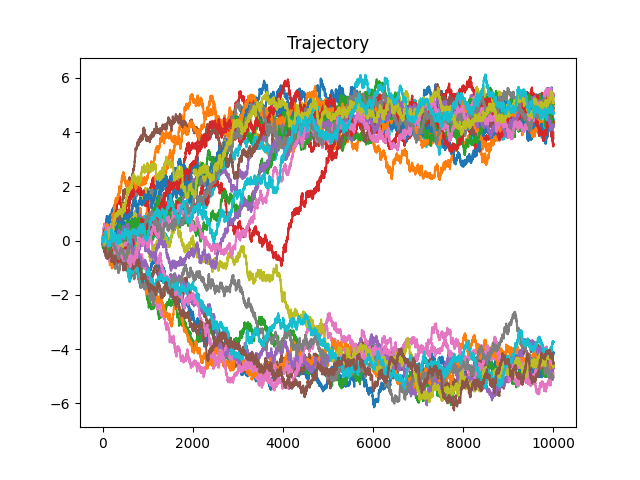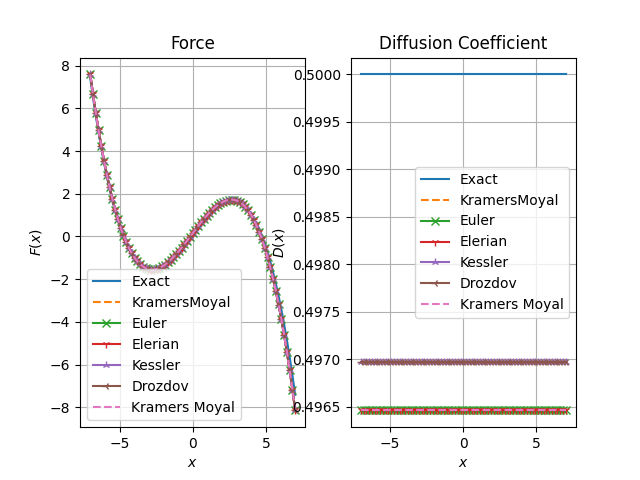Note
Go to the end to download the full example code.
1D Double Well¶
Estimation of an overdamped Langevin.
import numpy as np
import matplotlib.pyplot as plt
import folie as fl
coeff = 0.2 * np.array([0, 0, -4.5, 0, 0.1])
free_energy = np.polynomial.Polynomial(coeff)
D = 0.5
drift_coeff = D * np.array([-coeff[1], -2 * coeff[2], -3 * coeff[3], -4 * coeff[4]])
drift_function = fl.functions.Polynomial(deg=3, coefficients=drift_coeff)
diff_function = fl.functions.Polynomial(deg=0, coefficients=np.array(D))
# Plot of Free Energy and Force
x_values = np.linspace(-7, 7, 100)
# fig, axs = plt.subplots(1, 2)
# axs[0].plot(x_values, free_energy(x_values))
# axs[1].plot(x_values, drift_function(x_values.reshape(len(x_values), 1)))
# axs[0].set_title("Potential")
# axs[0].set_xlabel("$x$")
# axs[0].set_ylabel("$V(x)$")
# axs[0].grid()
# axs[1].set_title("Force")
# axs[1].set_xlabel("$x$")
# axs[1].set_ylabel("$F(x)$")
# axs[1].grid()
# Define model to simulate and type of simulator to use
dt = 1e-3
model_simu = fl.models.overdamped.Overdamped(drift_function, diffusion=diff_function)
simulator = fl.simulations.Simulator(fl.simulations.EulerStepper(model_simu), dt)
# initialize positions
ntraj = 30
q0 = np.empty(ntraj)
for i in range(len(q0)):
q0[i] = 0
# Calculate Trajectory
time_steps = 10000
data = simulator.run(time_steps, q0, save_every=1)
# Plot resulting Trajectories
fig, axs = plt.subplots()
for n, trj in enumerate(data):
axs.plot(trj["x"])
axs.set_title("Trajectory")
fig, axs = plt.subplots(1, 2)
axs[0].set_title("Force")
axs[0].set_xlabel("$x$")
axs[0].set_ylabel("$F(x)$")
axs[0].grid()
axs[1].set_title("Diffusion Coefficient")
axs[1].set_xlabel("$x$")
axs[1].set_ylabel("$D(x)$")
axs[1].grid()
xfa = np.linspace(-7.0, 7.0, 75)
axs[0].plot(xfa, model_simu.pos_drift(xfa.reshape(-1, 1)), label="Exact")
axs[1].plot(xfa, model_simu.diffusion(xfa.reshape(-1, 1)), label="Exact")
traindrift = fl.functions.Polynomial(deg=3, coefficients=np.array([0, 0, 0, 0]))
trainmodel = fl.models.Overdamped(traindrift, diffusion=fl.functions.Polynomial(deg=0, coefficients=np.asarray([0.9])), has_bias=False)
name = "KramersMoyal"
estimator = fl.KramersMoyalEstimator(trainmodel)
res = estimator.fit_fetch(data)
axs[0].plot(xfa, res.drift(xfa.reshape(-1, 1)), "--", label=name)
axs[1].plot(xfa, res.diffusion(xfa.reshape(-1, 1)), "--", label=name)
for name, marker, transitioncls in zip(
["Euler", "Elerian", "Kessler", "Drozdov"],
["x", "1", "2", "3"],
[
fl.EulerDensity,
fl.ElerianDensity,
fl.KesslerDensity,
fl.DrozdovDensity,
],
):
estimator = fl.LikelihoodEstimator(transitioncls(trainmodel))
res = estimator.fit_fetch(data)
# print(res.coefficients)
axs[0].plot(xfa, res.pos_drift(xfa.reshape(-1, 1)), marker=marker, label=name)
axs[1].plot(xfa, res.diffusion(xfa.reshape(-1, 1)), marker=marker, label=name)
name = "Kramers Moyal"
res = fl.KramersMoyalEstimator(trainmodel).fit_fetch(data)
axs[0].plot(xfa, res.pos_drift(xfa.reshape(-1, 1)), "--", label=name)
axs[1].plot(xfa, res.diffusion(xfa.reshape(-1, 1)), "--", label=name)
axs[0].legend()
axs[1].legend()
# Compute MFPT from one well to another
plt.figure()
x_mfpt, mfpt = fl.analysis.mfpt_1d(model_simu, -5.0, [-10.0, 10.0], Npoints=500)
plt.plot(x_mfpt, mfpt, label="Right to left")
x_mfpt, mfpt = fl.analysis.mfpt_1d(model_simu, 5.0, [-10.0, 10.0], Npoints=500)
plt.plot(x_mfpt, mfpt, label="Left to right")
x_mfpt, mfpt = fl.analysis.mfpt_1d(res, -5.0, [-10.0, 10.0], Npoints=500)
plt.plot(x_mfpt, mfpt, label="Right to left Estimation")
x_mfpt, mfpt = fl.analysis.mfpt_1d(res, 5.0, [-10.0, 10.0], Npoints=500)
plt.plot(x_mfpt, mfpt, label="Left to right Estimation")
plt.legend()
plt.show()
Total running time of the script: (0 minutes 6.841 seconds)


